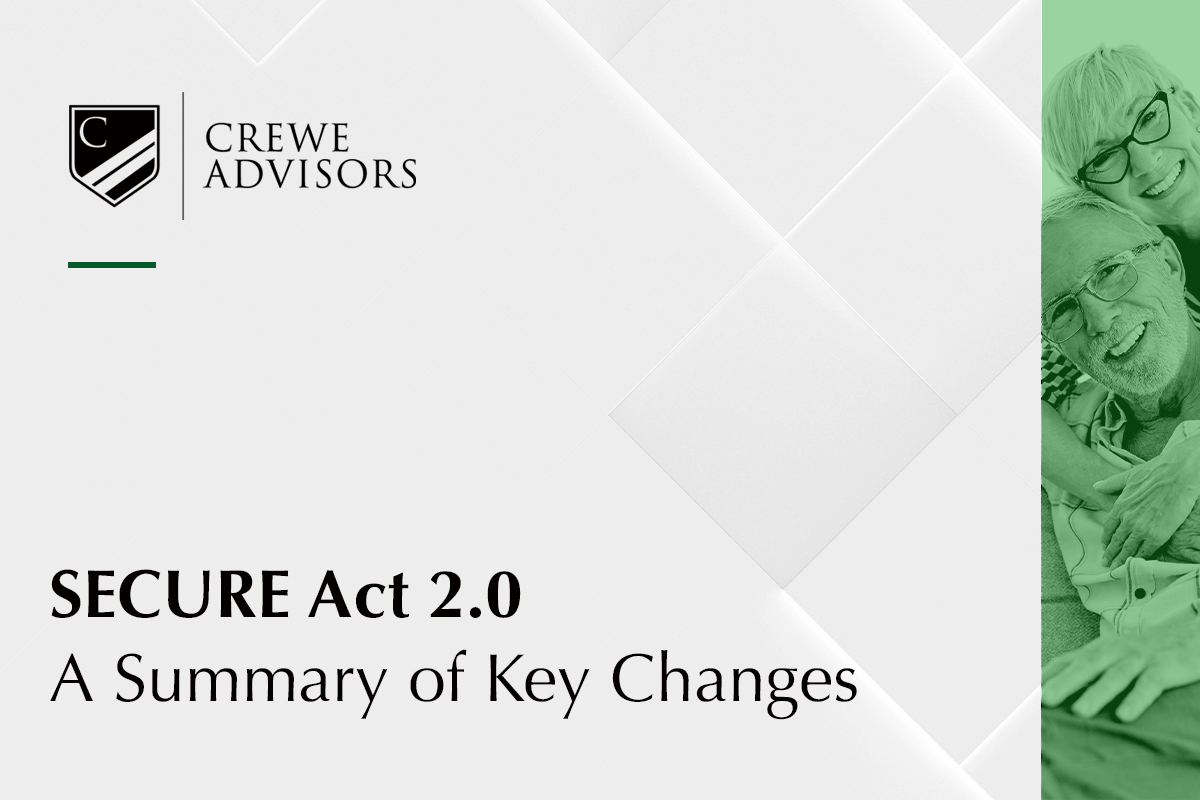The Consolidated Appropriations Act, 2023, was signed into law on December 29, 2022 by President Biden after receiving overwhelming bi-partisan support in both the House and Senate. It includes several key retirement and tax provisions, commonly known as the SECURE Act 2.0.
SECURE Act 2.0 seeks to build on the original SECURE Act of 2019 by providing additional retirement planning flexibility and more options for Americans to save for their own retirement. Some provisions may have an immediate impact on your retirement strategy – here is a summary of several of the key changes:
Changes to Required Minimum Distributions [RMDs]
- Beginning January 1, 2023 the age at which retirement account owners must take RMDs increases from 72 to 73. In 2033, the age increases to 75.
- The penalty for failing to take RMDs will be reduced significantly – from 50% to 25% of the RMD amount not taken.
**Planning tip: Delaying RMDs may not always result in the biggest tax savings – depending on your current and future tax circumstances, considering Roth conversions or taking partial distributions prior to age 73 may help mitigate tax consequences in the future.
Increased Catch-Up Contributions
- The catch-up contribution limit for employer-sponsored retirement plans is increased to $7,500 for plan participants age 50 or older, and will be adjusted for inflation in future years.
- Starting January 1, 2025, catch-up contributions for individuals ages 60-63 will be increased to $10,000 annually ($5,000 for certain types of plans) and will be indexed for inflation as well.
- The catch-up contribution limit for IRAs for individuals age 50 or older will be indexed for inflation for years beginning after 2023.
**Planning tip: Catch-up contributions for individuals earning more than $145,000 must be made to a Roth account (using after-tax dollars). However, putting more aside either on a tax-advantaged or after-tax basis helps boost retirement savings.
Retirement Plan Changes
- Automatic Enrollment: New retirement plans adopted by businesses must automatically enroll all eligible employees at a 3% contribution rate (unless the employee specifically opts out) and encourages retirement plan providers to offer automatic portability so individuals can easily take their retirement savings with them when they change jobs.
- Contributions for those with Student Loan Debt: Starting in 2024, employers may make contributions to retirement plans on behalf of any employees who are not making contributions but repaying student loans.
**Planning tip: These provisions provide an opportunity for employers to attract and retain talent.
Modifications to Roth Accounts
- Beginning in 2023, individuals may elect to have their employer matching contributions directed to their Roth 401ks (to allow for increased after-tax retirement savings). Keep in mind these contributions will be treated as taxable income in the year they are made.
- Beginning in 2024:
- RMDs are eliminated from workplace-based Roth plans.
- A portion of unused 529 plan funds may be rolled tax-free into a Roth IRA for the named beneficiary of the 529 plan. The annual rollover amount is subject to the Roth contribution limits (currently $6,500/year) and a $35,000 lifetime limit.
Expansion of Penalty-free Withdrawals
- Several new exceptions to the 10% penalty imposed on distributions taken from a retirement account prior to reaching age 59 ½ include:
- $1,000 may be withdrawn from a retirement account once per year if needed for emergency expenses. Any amount withdrawn must be repaid within 3 years.
- Distributions taken from a retirement account by individuals that have a terminal illness (certified by a physician) are not subject to penalty.
- Victims of domestic abuse may take hardship withdrawals up to the lesser of $10,000 or the vested balance of the account (adjusted for inflation).
**Planning tip: All of the above early withdrawals only qualify for waiver of penalty if the full amount is repaid within 3 years.
It is important for everyone to consider their own unique financial situation when interpreting these new rules. Reach out to your wealth advisor today to learn more about how SECURE Act 2.0 might affect your retirement planning and which opportunities might be suitable for you.
